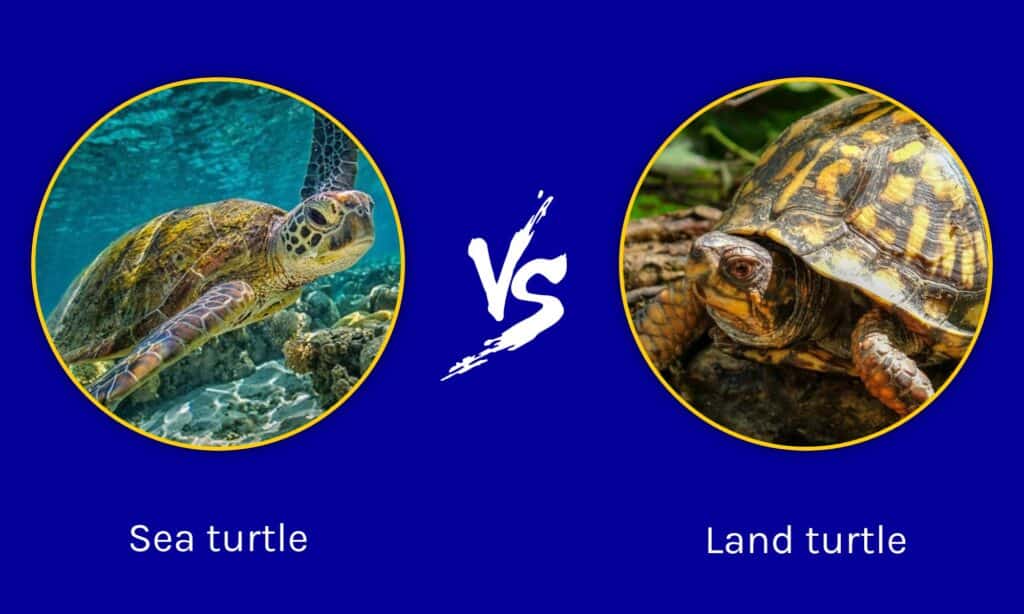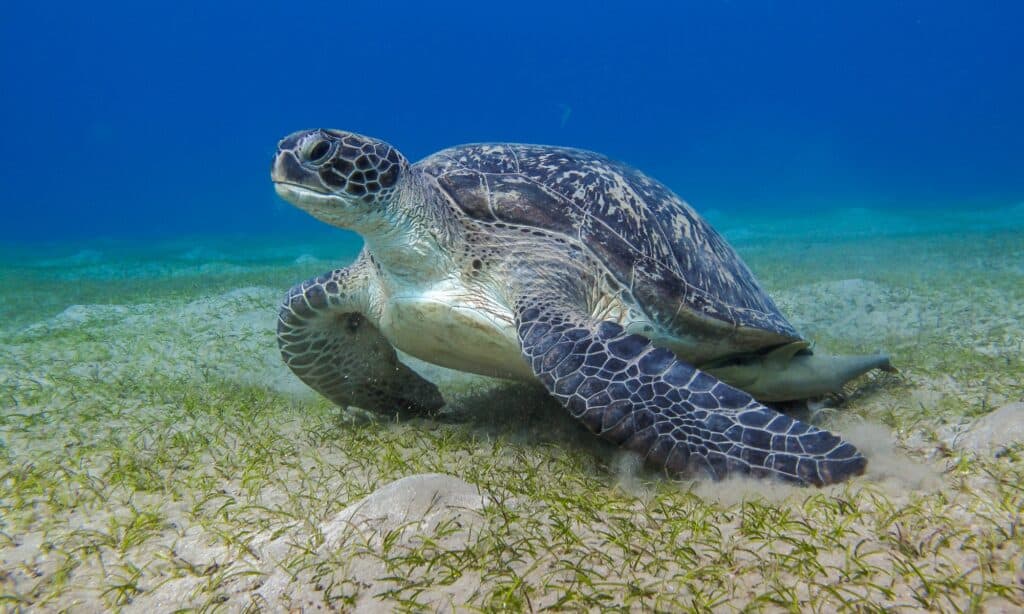You can find turtles pretty much anywhere you look. While it may not be turtles all the way down, they certainly are all around! While most people know about sea turtles, many don’t know that there are land turtles that aren’t considered tortoises. Today, we are going to discover the similarities and differences between the Sea Turtle vs Land Turtle!
Comparing a Sea turtle and a Land turtle

| Land turtle | Sea turtle | |
|---|---|---|
| Taxonomy | Order: Testudines Genus: Terrapene and Cuora | Order: Testudines Superfamily: Chelonioidea |
| Appendages | Legs designed for walking | Flippers designed for swimming and eating |
| Shells | Hard outer shell. Retractable. | Two types of shell, neither retractable. |
| Diet | Omnivorous. | Varies with species. |
| Distribution | United States, Mexico, Asia | Worldwide oceans. |
| Habitat | Varies, but commonly found in woodlands and marshes. | All oceans except for the polar regions. |
| Conservation status | Declining. | Threatened, endangered, or critically endangered (depending on the species). |
The 7 main differences between a sea turtle and a land turtle
The main differences between a sea turtle and a land turtle are that sea turtles live in the ocean, have flippers, and can’t retract into their shells. Subsequently, land turtles live on land, have legs, and can retract into their shells.
Sea turtles are well-known inhabitants of the world’s oceans, but few people know as much about land turtles. Both sea turtles and land turtles are related and belong to the Testudines order. The split between the two, however, occurs around the taxonomic family, with sea turtles divided into a superfamily Chelonioidea and land turtles being specifically assigned to the genus Terrapene and Cuora.
There is a distinct difference between land turtles and the tortoise. Land turtles are otherwise known as box turtles and exist within two groups: box turtles related to the American pond turtles and the Asian box turtles. Both of these groups are land-based turtles that are distinct from other land-dwelling members of Testudines known as tortoises.
Sea turtles live in the ocean, while box turtles live on land. Additionally, the habitats and distribution of these two animals are distinctly different. Let’s take a look at these differences, plus a few more, below.
Sea Turtle vs Land Turtle: Taxonomy

Sea turtles belong to the superfamily Chelonioidea, and land turtles belong to the Terrapene and Cuora genera.
©Achimdiver/Shutterstock.com
There are seven species of sea turtles (all divided into their own genus). Sea turtles, along with all other turtles, tortoises, and terrapins, belong to the Testudines order. Marine-dwelling turtles within this order can all be grouped under the superfamily Chelonioidea. In short, members of the superfamily Chelonioidea are referred to as sea turtles. You can further break sea turtles into two groups: those with hard shells and those with leathery shells.
Land turtles, like sea turtles, belong to the Testudines order. Unlike a large family of related turtles (like the sea turtles and the Chelonioidea superfamily), land turtles can all be grouped into the genus Terrapene and Cuora. Members of the Terrapene genus are called box turtles and are closely related to the American pond turtles. Members of the Cuora genus are called Asian box turtles and are also considered land turtles.
Sea Turtle vs Land Turtle: Appendages

Land turtles have feet for movement.
©iStock.com/SteveByland
One of the easiest ways to tell the difference between a sea turtle and a land turtle is the appendages. Sea turtles have four flippers instead of legs. The two front flippers are generally longer than the two back flippers. Sea turtles use these flippers to swim, swipe, forage, and even hold their food.
Box turtles, both the American and Asian groups, have legs with claws. Since box turtles are terrestrial, true legs are essential for long-term locomotion. While some box turtles will occasionally venture into swampy regions, true swimming and diving are nearly impossible.
Sea Turtle vs Land Turtle: Shells

Sea turtles have shells that protect them from predators.
©iStock.com/YasserBadr_Beenthere
While both sea turtles and land turtles have shells, they are quite different. Sea turtles have large, expansive shells that help protect them from predators. There are two types of sea turtle shells: hard and leathery. Only one sea turtle species, the leatherback turtle, has a leathery shell. Regardless, both types of sea turtle aren’t able to retract into their shells if threatened.
Box turtles have very hard shells. Additionally, box turtles are able to retract their legs and head into their shells. A special adaptation that box turtles have is the ability to hinge their shell closed, totally protecting themselves from a potential predator.
Sea Turtle vs Land Turtle: Diet

Land turtles are primarily omnivorous, while sea turtles have varied diets.
©iStock.com/Alan Doucet
The diets of sea turtles vary quite a bit. Of the seven species, the loggerhead, Kemp’s ridley, olive ridley, and hawksbill turtles are omnivorous. Their diet includes decapods, grasses, seaweed, sponges, worms, fish, and more. Green sea turtles become totally herbivorous as they mature, leatherback turtles only eat jellyfish, and hawksbill turtles eat mostly sponges.
Land turtles are primarily herbivorous and will eat pretty much anything. They are known to eat worms, insects, vegetation, fruit, and gastropods.
Sea Turtle vs Land Turtle: Distribution

You can find sea turtles in almost all of the world’s oceans.
©iStock.com/Greg Sullavan
Sea turtles can be found in every ocean of the world, save for the polar regions.
Box turtles are native to North America. They can now be found across most of the United States, northern Mexico, and the Yucatan Peninsula. The Asian box turtle can be found from China to Indonesia and the Philippines, Southeast Asia, and northern India and Bhutan.
Sea Turtle vs Land Turtle: Habitat

Land turtles can live in grasslands, forests, and even deserts.
©Jessica Baldwin/Shutterstock.com
As a marine reptile, sea turtles are exclusively in the oceans of the world. They generally prefer regions near continental shelves but often venture into seaweed growths, shorelines, and coral reefs.
Box turtles are pretty variable when it comes to their habitats. Generally, the various species of box turtle can be found in forests, grasslands, deserts, and even rainforests.
Sea Turtle vs Land Turtle: Conservation status
Unfortunately, every species of sea turtle in the world is at risk.
| IUCN Red List | Status |
|---|---|
| Green | Endangered |
| Loggerhead | Endangered |
| Kemp’s ridley | Critically endangered |
| Olive ridley | Vulnerable |
| Hawksbill | Critically endangered |
| Flatback | Data deficient |
| Leatherback | Vulnerable |
Certain species of box turtles are endangered or near threatened. Despite the listing, these turtles generally have large populations. Still, they are on the decline in some places.
The photo featured at the top of this post is © John Back/Shutterstock.com
Thank you for reading! Have some feedback for us? Contact the AZ Animals editorial team.






